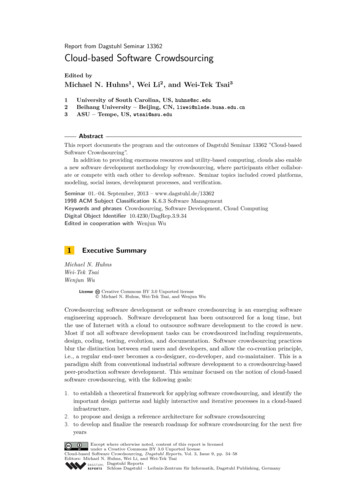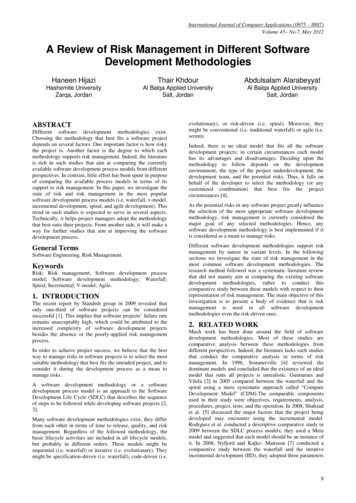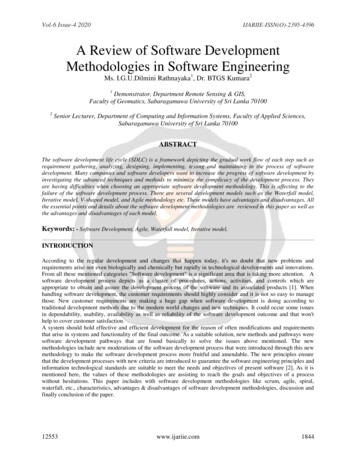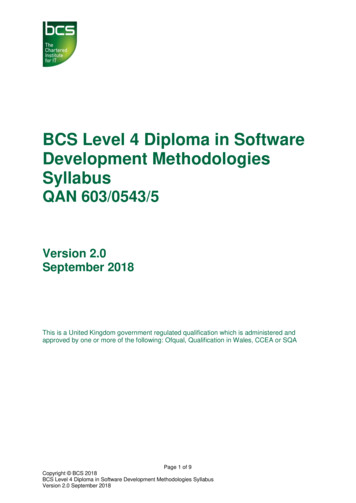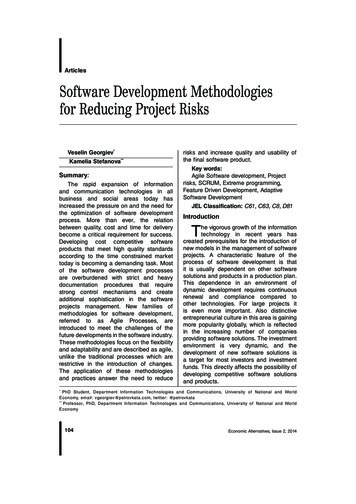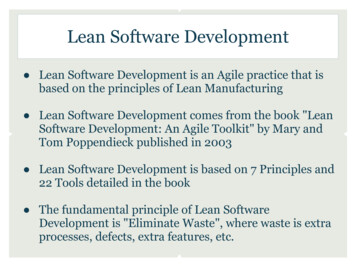
Transcription
Supporting Software Development throughDeclaratively Codified Programming PatternsKim Mens, Isabel MichielsRoel Wuyts{ kimmens Isabel.Michiels }@vub.ac.beRoel.Wuyts@iam.unibe.chProgramming Technology LabSoftware Composition GroupDepartment of Computer ScienceInstitut für InformatikVrije Universiteit Brussel, BelgiumUniversität Bern, SwitzerlandAbstractIn current-day software development, programmers often use programming patterns to clarify their intents and toincrease the understandability of their programs. Unfortunately, most software development environments do not adequately support the declaration and use of such patterns.To explicitly codify these patterns, we adopt a declarativemeta-programming approach. In this approach, we reify thestructure of an (object-oriented) program in terms of logicclauses. We declare programming patterns as logic ruleson top of these clauses. By querying the logic system, theserules allow us to check, enforce and search for occurrencesof patterns in the software. As such, the programming patterns become an active part of the development and maintenance environment.Keywords: programming patterns, logic programming,meta-programming, tool support1 IntroductionContemporary software development practice regardssoftware construction as an incremental and continuous process that involves large development teams. In such a context, it is crucial that the software is as readable as possible.One cannot afford that programmers have to wade throughpiles of documentation and code to understand the softwareor to discover the intents of the original programmers. Instead, they should spend their precious time to tackle thereal problem (that is, the task of programming itself, i.e.conceptualizing, designing, implementing and maintenance[7]).By using commonly accepted programming (and design)patterns, it becomes much easier for programmers to communicate their intents [1]. A problem with ad-hoc patterns,however, is that they are not supported by the programminglanguage nor by the development environment. For example, whether or not a certain programming pattern is consistently used throughout a program solely depends on theprogrammers’ discipline.By relieving the mind of all unnecessary work, agood notation sets it free to concentrate on moreadvanced problems, and in effect increases themental power of the race.Alfred North WhiteheadTo allow programmers to gain maximum profit from theextra information that is encoded in patterns, there is a needfor tools that support the use of such patterns. We envisionthe patterns as becoming an explicit and active part of thedevelopment environment. Some activities that such an environment should support are: checking whether a piece of source code matches a pattern; finding all pieces of code that match a pattern; searching for all occurrences of patterns that were usedto program a piece of source code; detecting violations of the usage of a pattern; enforcing the consistent use of a pattern throughout aprogram; generating code that matches a pattern.This paper advocates the use of a declarative metalanguage for expressing and reasoning about programmingpatterns in object-oriented programs.
2 Declarative Meta-ProgrammingDeclarative meta-programming (DMP) is an instance ofhybrid language symbiosis, merging a declarative languageat meta-level with a standard (object-oriented) base language. Base-level programs are expressed in terms of factsand rules at the meta-level. Programming patterns are expressed as rules that reason about the clauses representingthose base-level programs. By querying the logic system,the rules can be used to check, detect, search for occurrences of and even generate code fragments from programming patterns. Before discussing what the programmingpattern rules look like, we first elaborate on the base andmeta-language.As declarative meta-language, we use a Prolog-variant.Logic programming has long been identified as very suitedto meta-programming and language processing in general.Prolog’s expressive power (e.g. unification and backtracking) and its capacity to support multi-way reasoning 1 areparticularly attractive to reason about patterns.Although DMP can be applied to programs writtenin any programming language, in this paper we takethe object-oriented language Smalltalk as base language.One reason for choosing Smalltalk for our experiments isthat there exists a “Smalltalk culture” which makes thatSmalltalk programmers use a lot of well-known patterns toexpress important intents [1, 3], but for which no explicitlanguage constructs are available.2.1 SetupA DMP environment consists of 4 main elements. In alogic language, we declare programming patterns as logicmeta-programs that reason about programs written in an(object-oriented) base language. The logic meta-programsare stored in a logic repository. The base-level languageconstructs are stored in an implementation repository thatcan be accessed from within the logic language, by meansof a meta-level interface.For the experiments in this paper, we used the logic language SOUL [8] to allow powerful logic reasoning aboutSmalltalk programs. SOUL was implemented in Smalltalkand contains a primitive construct, called “Smalltalk term”,for evaluating Smalltalk expressions as part of logic rules.This allows SOUL clauses to reason about Smalltalk sourcecode by making direct meta-calls to the Smalltalk image.1 A prototypical example is the append/3 predicate, which can be usedto append two lists, check whether a list is the concatenation of two others,check for and generate prefixes and postfixes of a list, and so on.2.2 The Representational MappingThe representational mapping defines the meta-levelinterface between the declarative meta-language and theobject-oriented base language. For each base-language construct we want to reason about at meta-level, there is a logicfact or rule which reifies that construct at meta-level. Figure1 lists some of the predicates that constitute this representational mapping. 2Reification is achieved by using SOUL’s symbiosis withSmalltalk to access the Smalltalk image directly by executing a piece of Smalltalk code as part of a logic rule. E.g.,the SOUL rules below reify the notion of ‘classes’: 3Rule class(?Class) ifconstant(?Class),[Smalltalk includes: ?Class name].Rule class(?Class) ifvariable(?Class),generate(?Class, [Smalltalk allClasses]).The first rule declares what happens when the classpredicate is called with a constant value. In that case,the special Smalltalk term [Smalltalk includes: ?Class name]checks whether the value represents an existing class in theSmalltalk image. Note that a Smalltalk term used in theposition of a predication is required to return true or false.The second rule is applied when ?Class is variable. In thatcase, a primitive generate predicate is used to unify that variable (the first argument of the predicate) with each of theclasses present in the Smalltalk image. This is done by executing the Smalltalk expression between square brackets,which is provided as second argument to the generate predicate. A Smalltalk expression used in a generate predicate issupposed to return a collection of results.Given these rules, the query Query class([Array]) verifieswhether Array is an existing class in the Smalltalk image,whereas the query Query class(?Class) unifies ?Class with aclass in the Smalltalk image. Note that a Smalltalk termused in the position of a logic term can return any value.Other rules that reify Smalltalk language constructs aredefined in a similar way; see [5, 9] for more examples. Inthe next section, we show how best practice patterns, designpatterns and other programming patterns can be encoded inSOUL.2 Inthis table, a variable ?C represents a Smalltalk class, ?M a methodparse tree, ?N a method name, ?V an instance variable name, ?P the nameof a Smalltalk method protocol, ?MC a Smalltalk meta-class, ?Stats a listof Smalltalk statements and ?Args a list of names of argument variables.3 In SOUL, the keyword if separates the body from the head of a Rule; logic variables start with question marks; a comma denotes logical conjunction; lists are delimited with and terms between square bracketsrepresent Smalltalk expressions that may contain (bound) logic variables.
nProtocol(?C,?P,?M)subClass(?C1,?C2)Meaning?C is a classclass ?C implements method ?M with name ?Nmethod ?M has argument list ?Argsmethod ?M belongs to class ?Cmethod ?M has name ?Nmethod ?M has list of statements ?Stats in its bodyclass ?C has instance variable with name ?Vin class ?C1 message ?N with argument list ?Args is sent to receiver ?C2class ?C has meta-class ?MCmethod ?M of class ?C belongs to method protocol ?Pclass ?C1 has subclass ?C2Figure 1. The representational mapping3 Codifying Programming PatternsEvery programming language has its set of patterns thatexperienced programmers follow to produce more understandable code. They use such patterns to make clear theirintents and to improve the overall readability of the software. Well-known kinds of such patterns are best practicepatterns [1], design patterns [4], design heuristics [6], badsmells and refactoring patterns [2]. In this section, we illustrate some of these patterns and show how they can becodified in a DMP medium.3.1 Best Practice PatternsBeck’s “Smalltalk best practice patterns” capturecommonly accepted programming conventions forSmalltalk [1]. They suggest how to choose clear names forobjects, instance variables and methods, how to communicate the programmer’s intents through code, how to writeunderstandable methods, etc. As concrete examples wediscuss the Getting Method and Constructor Method bestpractice patterns.Provide a method that returns the value of thevariable. Give it the same name as the variable.One possible DMP implementation for representing thestructure of a Getting Method is given below. It declaresthat the statement list of a Getting Method consists of asingle statement, which merely returns the value of the instance variable ?V:Fact gettingMethodStats( return(variable(?V)) ,?V).Note that the above fact expresses only the simplest formof a Getting Method. Other forms of Getting Methods canbe codified by adding similar facts or rules. E.g., a Getting Method that uses ‘lazy initialization’ has an extra statement to initialize the value of the variable the first time thevariable is retrieved. Due to space limitations, we did notinclude these other forms here.The predicate gettingMethodStats only defines the statement list of a Getting Method. To check whether a methodof a class is a Getting Method for some instance variable,we need to verify that the instance variable belongs to thatclass, that the method has the same name as the variable andthat the method returns that particular instance variable. 43.1.1 Getting MethodOne way to make the distinction between state and behavior more transparent is by hiding every access to the stateof an object by a message send. This is the motivation behind the idea of accessing methods. An accessing methodis responsible for getting or setting the value of an instancevariable. All references to an instance variable should bemade by calling these methods. Methods that get the valueof a variable are Getting Methods; methods that set the valueof a variable are Setting Methods. The Getting Method bestpractice pattern [1] states:Getting Method How do you provide access toan instance variable?Rule gettingMethod(?Class,?Method,?InstVar) ifclassImplementsMethod(?Class, methodStatements(?Method,?Stats).This gettingMethod predicate states that ?Class has an instance variable ?InstVar and a Getting Method ?Method thatretrieves the value of that variable. 54 The underscore symbol ‘ ’ denotes a special variable of which theactual value is unimportant.5 To facilitate reasoning about method statements, a ?Method is represented as a logic data-structure that corresponds to the method’s parse tree,
3.1.2 The Constructor MethodThe Constructor Method best practice pattern indicates howyou best express the creation of a class instance [1]:The Constructor Method. How do you represent instance creation?Provide methods that create well-formed instances. Pass all required parameters to them.(Put Constructor Methods in a method protocolcalled “instance creation”.)The fact that all Constructor Methods are, by convention,put in the instance creation method protocol, makes it veryeasy to codify this pattern:Rule constructorMethod(?Class,?Meth) #’instance creation’],?Meth),returnType(?Meth,?Class).In Smalltalk, Constructor Methods are defined on metaclasses. Hence, we retrieve the meta-class and verify that?Meth belongs to its ‘instance creation’ method protocol. Asan extra consistency check, we verify that the ConstructorMethod returns an instance of the correct type ?Class, byusing an auxiliary predicate returnType(?Meth,?Class).This typing predicate returnType only ‘guesses’ the typebecause Smalltalk is dynamically typed. To infer the typeof the expression that is returned by the method, we look atall messages that are sent to that expression (in the contextwhere it occurs). A class is a possible type for that expression if it understands all these messages (if not, a ‘messagenot understood’ error may occur at run-time).3.2 Design PatternsWhereas best practice patterns define programming conventions at the level of single classes, methods or instancevariables, design patterns [4] have a more global scope andfocus on typical class collaborations. As with best practice patterns, we codify the structure 6 of design patternsas logic meta-programs that reason about the structure ofa base-level program. As an illustration, we codify the Visitor design pattern (structure).The general idea of the Visitor design pattern is to separate the structure of some elements from the operations thatcan be applied on these elements. This separation makesrather than as a string containing the original Smalltalk source code. Thepredicate methodStatements/2 matches a list of Smalltalk statementswith the statements occurring in such a parse tree.6 Note that a design pattern captures more than only the structure of aclass collaboration. It also has a motivation, intent, applicability, as wellas relationships with other design patterns. In this paper, however, we onlyfocus on the structure of design patterns.it easier and more cost-effective to add new operations,because the classes that describe the element structure donot need to be changed. Separating the nodes of a parsetree from the different operations performed on those nodes(such as generating code, pretty printing, optimizing) is thetypical example where the Visitor design pattern offers asolution.As shown in Figure 2, in the Visitor design pattern structure there is a hierarchy describing the elements and thereis a separate hierarchy implementing the operations. Assume that Element is the root class of a hierarchy on whichthe subclasses of the class Visitor define operations. EveryElement class defines a method accept that takes a Visitoras argument and calls this visitor. This call is in generalunique for that element. The Visitor hierarchy consists ofthe classes that define operations on the Element classes.They just need to implement the calls made by the differentelement classes.The rule describing the structure of the Visitor designpattern is fairly straightforward. First of all, it declares that?Visitor is a class that implements the visit method ?VisitSelector. In the same way, the class ?El implements a ?Methodcalled ?AcceptM. This method is responsible for calling thevisitor ?V with the actual visit operation ?VisitSelector. Finally we need to verify that one of the arguments of this callis the receiver (denoted by self in Smalltalk) and that thepassed visitor ?V is an argument of the accept method:Rule visitor(?Visitor,?El,?AcceptM,?VisitSelector) ifclassImplementsMethod(?Visitor,?VisitSelector, Statements(?Meth, return(send(?V,?VisitSelector,?VisitArgs)) dArguments(?Meth,?AccArgs),member(?V,?AccArgs).3.3 Other Programming PatternsNext to best practice patterns and design patterns, otherpatterns exist that check whether or not the software is welldesigned or well structured. Examples are Riel’s designheuristics [6] and Beck and Fowler’s bad smells [2]. As atypical example consider the following heuristic [6, Heuristics 5.6 and 5.7]:All abstract classes must be base classes and allbase classes should be abstract classes.This heuristic can be codified as follows:Rule abstractClassHeuristic() forall(baseClass(?Class),abstractClass(?Class)).
ElementVisitoraccept: aVisitorvisitConcreteElement1: evisitConcreteElement2: eConcreteElement1ConcreteElement2accept: aVisitoraccept: aVisitorConcreteVisitor1visitConcreteElement1: evisitConcreteElement2: eFigure 2. Visitor Design Pattern Structurewhere baseClass(?Class) checks whether ?Class is a classfrom which another class inherits and abstractClass(?Class)checks whether ?Class is abstract by verifying that it contains at least one abstract method. In Smalltalk, abstractmethods can be recognized because they make a subclassResponsibility self send. In other words, we check whethertheir statement list matches the following pattern: bility’], ) A second example of a programming pattern for detecting ill-designed code is the Duplicated Code bad smell [2]:Duplicated Code. . . A common duplication problem is when youhave the same expression in two sibling subclasses. . . .This ‘bad smell’, together with its proposed solution, is similar to Riel’s heuristic 5.10 [6], which suggests when andhow to refactor two classes that implement the same stateand behavior:If two or more classes have common data and behavior (i.e. methods) then those classes shouldeach inherit from a common base class whichcaptures those data and methods.Below, we codify two rules that check for a common expression in two classes.7 Two classes ?Class1 and ?Class2have common behavior if they implement a method withthe same method body.Rule commonBehavior(?Class1,?Class2,?Met1,?Met2) ifclassImplementsMethod(?Class1, ,?Met1),classImplementsMethod(?Class2, Statements(?Met2,?Statements).Rule commonData(?Class1,?Class2,?InstVar) e(?Class2,?InstVar,?Type).Similar to the returnType predicate, our lightweight type inference rules guess the type of an instance variable by looking at all messages sent to that variable (in the scope of itsclass) and computing all classes that understand all thesemessages. In addition, initialization of variables, as well asfactory methods and getting and setting methods are takeninto account.4 Supporting Software DevelopmentIn the previous section we used DMP to declare manykinds of programming patterns. In this section we elaborateon how a programmer can use these rules to support himwhen developing or maintaining software. The rules can beused in different ways: checking whether a certain pattern issatisfied, searching source code that matches some pattern,detecting violations of patterns, and even code generation.4.1 Checking and SearchingDue to the multi-way reasoning capability of our logiclanguage, most predicates can be used in multiple ways. Toillustrate this, let us elaborate on the gettingMethod predicateof Subsection 3.1.1. When calling the predicate with constant arguments, it merely checks whether a given methodof a given class is a Getting Method for a given instancevariable. When the query contains variables, we search forall values that satisfy the pattern. For example,Query �])Having common data is codified as having a common instance variable ?InstVar of the same type.7 Tosave space we only show the simplest implementation.returns the Getting Method for the variable ‘builder’ of theSmalltalk class ApplicationModel. We can even use morethan one logic variable, as in
Query gettingMethod([ApplicationModel],?M,?InstVar)which finds all Getting Methods together with their corresponding instance variable for the class ApplicationModel.We can also use the predicate in the opposite way to findall classes that have a Getting Method for a given instancevariable ‘name’:Query gettingMethod(?Class,?Method,[#’name’])Again, this query returns several results (one for each of theclasses that implements such a Getting Method).Finally, we can call the predicate with variables only,in which case all classes in the entire Smalltalk image aresearched for Getting Methods. Computing such a querymay take a very long time, however.A similar reasoning can be made for all other predicatesthat were defined in Section 3. As a second example of“checking and searching” we revisit the commonBehaviorrule of Subsection 3.3 that tells us when to move commonbehavior in sibling subclasses to their common base class.We can use the rule below to find all classes ?C1 and ?C2 thatshould be refactored or to detect whether two classes havesome behavior in common, and so on. The rule also returnsthe common base class and the methods to be moved.We can then invoke the query below to find all violations of the Getting Method pattern. It returns the violatingmethod ?Meth that directly accesses some instance variable?IV, together with the class ?Class it belongs to and the violating message ?Msg it sends to the instance variable.Query accessingViolator(?Class,?Meth,?IV,?Msg)Visitor Design Pattern As an illustration of how to usethe visitor predicate of Subsection 3.2 for detecting violations, consider some class hierarchy with root class ParseTreeElement representing a parse tree. We want to detect allnon-abstract parse tree elements that do not comply to theVisitor pattern. To do so, we select all subclasses of ParseTreeElement that are not abstract, and for each of those wefind the ones that do not comply to the visitor rule:Query :’],?VisSel))Rule behaviorRefactoring(?C1,?C2,?Base,?M1,?M2) havior(?C1,?C2,?M1,?M2).The last line in this query mentions the name of the visitmethod (i.e., ‘doNode:’) used by the visitor to visit thenodes. When we do not know the name of this method,we can leave it variable. The system will then deduce thename used in this specific instance of the visitor pattern.The results of this query contain the methods that do notcomply to the Visitor design pattern, and that might needto be reimplemented. If the query fails, this means that allclasses and methods satisfy (the structure of) the Visitor design pattern.4.2 Detecting Violations4.3 Code GenerationGetting Method Coming back to the Getting Method pattern, in addition to checking whether a method is a GettingMethod and searching the image for occurrences of GettingMethods, we can also write queries that check the sourcecode for violations of the Getting Method pattern.Methods that violate the encapsulation imposed by theGetting Method programming pattern are methods that directly send messages to instance variables (with the exception of Getting Methods themselves, because they are theonly ones allowed to do so). The rule for detecting such violations verifies whether no method implemented in a classsends messages that have as receiver an instance variable ofthat class:Getting Method Instead of searching for Getting Methods and violations thereof, it can be useful to generate automatically the code of the Getting Methods for some instancevariable of a class. This can be done by combining the gettingMethodStats predicate describing the body of a GettingMethod with a primitive predicate generateMethod that generates the source code of a method from its logic parse treedescription.8Rule accessingViolator(?Class,?Meth,?IV,?ViolMsg) , tTo(?Class,variable(?IV),?ViolMsg, ).Rule generateAccessor(?Class,?InstVar) ifinstVar(?Class,?InstVar),“Verify that no method with name ?InstVar , )),gettingMethodStats(?Stats,?InstVar),“Generate code from the method parse tree r, , ,?Stats)).8 A method parse tree description consists of five parts: the method’sclass, the name of the method, its argument list, a list of temporary variables and a statement list.
Due to space limitations, we do not show the detailed implementation of the generateMethod predicate. It is a metapredicate that makes use of the strong symbiosis betweenSOUL and Smalltalk to add the method (in parse-tree format) it takes as input to the Smalltalk image; see [9] formore details.Behavior refactoring As a second example of code generation, we reconsider the predicate behaviorRefactoring ofSubsection 4.1. It only searches the image for commonmethods to be refactored. To perform the actual refactoring, we codify the Pull Up Method refactoring pattern [2].Pull Up MethodYou have methods with identical results on subclasses.Move them to the superclass.We only show the easiest case where two methods haveexactly the same body (typically as a result of “copy andpaste” programming). The rule below defines how to do therefactoring. The comments (between parentheses) explainthe code; the mechanics of the refactoring corresponds towhat is described in [2].Rule pullUpMethod(?C1,?C2) if“Check that ?C1 and ?C2 have common M2),“Retrieve information about the common s(?M1,?Temps),“Verify that the common base class ?Base doesnot implement a method with the same name”not(classImplementsMethod(?Base,?Name, )),“Generate code for the new Temps,?Stats)),“Delete code of the old methods”removeMethod(?M1),removeMethod(?M2).In addition to the generateMethod meta-predicate, this ruleuses a removeMethod meta-predicate to remove a givenmethod from the Smalltalk image.Being able to generate code has the important advantage that a programmer gains time to concentrate on moreintellectually-rewarding development or maintenance activities. Straightforward coding tasks can be performed partially. For example, we might imagine having some kind ofdesign pattern tool where we just select some pattern fromwhich a code template is automatically generated for theprogrammer to fill in.In the next section, we further elaborate on possible toolsupport and on how to integrate the DMP language with anexisting development environment.5 Tool SupportOur logic meta-language SOUL is well integrated inthe Smalltalk development environment. It can reasonabout and manipulate Smalltalk entities directly and caneven execute parameterized Smalltalk source-code fragments. Conversely, SOUL queries can be executed fromwithin Smalltalk itself. All this is achieved by implementing SOUL in Smalltalk and by using the powerful reflectivecapabilities of Smalltalk to obtain a good symbiosis withthe logic language.More recently, SOUL was extended with a synchronization framework to build tools that rely on some kind of synchronization between design 9 and implementation [9]. Itenables the construction of tools that monitor and act uponany change to the implementation or design. For example,we can make a tool to enforce the use of certain patterns inthe implementation. Suppose that we want to enforce theconsistent usage of the Getting Method best practice pattern throughout a program. The tool monitors all changesto methods and gives an error or warning whenever a programmer accepts a method that accesses an instance variable directly instead of through a Getting Method.In our experiments we worked directly at the level of thelogic meta-language. We defined our own logic rules andused logic queries directly to reason about patterns. However, for programming patterns to become an explicit andactive part of the development environment we need wellintegrated and user-friendly support tools in that environment.One of the already developed tools is the ‘Structural FindApplication’, a sophisticated search engine. This tool transparently uses logic queries to allow searching for methodsor classes in the Smalltalk image using complex search patterns. The user only needs to fill in one or more simpleselection fields and the Find Application will automaticallygenerate and interpret the corresponding query for the user.For example, the Find Application may be used to find allclasses that have a name matching some pattern, have amethod sending some specified message and implement amethod with some name. The results of the search are presented in a user-readable format.A second interesting tool that has been implemented ontop of SOUL is the ‘To Do Application’. During implementation of a program it logs all violations of certain programming patterns, conventions and heuristics in a “to do” list.This list can be inspected later by the programmer to fix (orignore) the detected problems.9 orother high-level descriptions on top of the implementation
A third example (which is currently being dev
struct we want to reason about at meta-level, there is a logic fact or rule which reifies that construct at meta-level. Figure 1 lists some of the predicates that constitute this representa-tional mapping.2 Reification is achieved by using SOUL's symbiosis with Smalltalk to access the Smalltalk image directly by execut-




